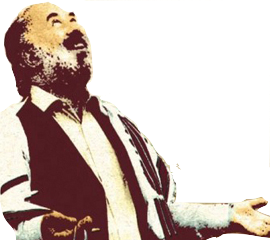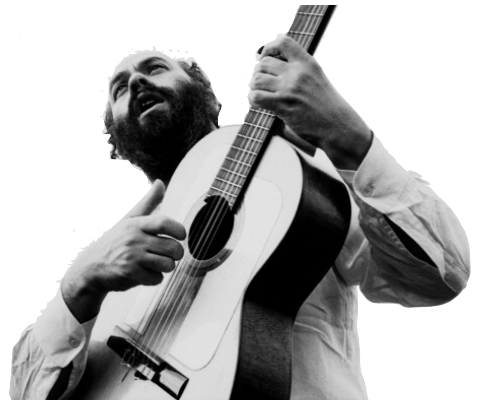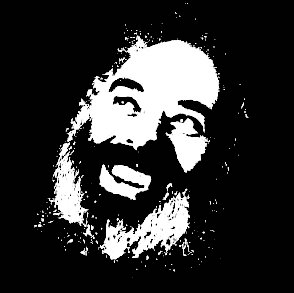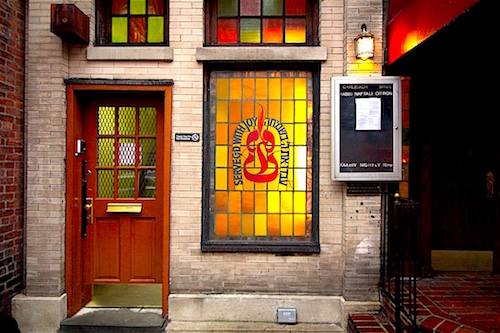
SHLOMO CARLEBACH
Shlomo Carlebach (Hebrew: שלמה קרליבך), known as Reb Shlomo to his followers (14 January 1925 – 20 October 1994), was a rabbi, religious teacher, composer, and singer who was known as “The Singing Rabbi” during his lifetime. Although his roots lay in traditional Orthodox yeshivot, he branched out to create his own style, combining Torah learning, Hasidic Judaism, warmth and personal interactions, and song-filled services. At various times in his life, he lived in Manhattan, San Francisco, Toronto and Moshav Mevo Modi’im, Israel.
BIOGRAPHY
Shlomo Carlebach was a descendant of an old Jewish rabbinical dynasty. The Carlebach family still remains a prominent Jewish family. Shlomo Carlebach was born in 1925 in Berlin, where his father, Rabbi Doctor Naftali Hartwig Carlebach (1889–1967), was an Orthodox rabbi. His family left Germany in 1933 and moved to Baden bei Wien, Austria, where they stayed until 1939, when the situation became too dangerous for the Jews in Austria. They immigrated to England, and then in 1940 they moved to the United States. Rav Naftali became the spiritual leader of the Young Israel of Brooklyn. After a few years, the family moved to New York City’s Upper West Side where Rav Naftali assumed the pulpit of Congregation Kehilath Jacob, a small synagogue on West 79th Street.
Shlomo Carlebach studied at Yeshiva Torah Vodaas and Yeshiva Chaim Berlin in Brooklyn, New York, as well as Beth Medrash Gevoha in Lakewood, New Jersey. His aptitude for Torah study was recognized by great Torah scholars and teachers, including Rabbi Shlomo Heiman and the Rosh Yeshiva of Bais Medrash Gevoha, Rabbi Aharon Kotler. For the short time that Reb Shlomo was there, Rabbi Kotler considered Reb Shlomo one of his top students. Rabbi Yitzchok Hutner, who gave Reb Shlomo Smicha (Rabbinic ordination), considered it a loss to the Torah world that Reb Shlomo chose a career in Jewish outreach instead of one as a scholar and teacher.
In 1950, Reb Shlomo set up a small Torah learning group which he called T.S.G.G. (pronounced TASGIG), an acronym for “Taste And See G-d Is Good”. That year, Reb Shlomo attended a Hebrew language ulpan at the Jewish Theological Seminary (JTS), where during his free time he would play Hasidic melodies on the piano. One of those impressed by his playing was Sara Schafler-Kelman, who invited Reb Shlomo to sing at the Hillel Center on Convent Avenue. On Schafler’s poster for the event, she wrote “The Place of Music in the Hasidic Tradition.” This was Reb Shlomo’s first invited performance. Years later, Reb Shlomo said to Schafler-Kelman, “You gave me a title for my life’s work.”

In 1972, Reb Shlomo married Elaine Neila Glick, a teacher. They had two daughters, Nedara (Dari) and Neshama Carlebach. Neshama Carlebach is a songwriter and singer in her own right, basing herself on her father’s style and name.

MUSIC CAREER
Shlomo Carlebach began writing songs in the end of the 1950s, primarily based on verses from the Tanach, set to his own tunes. Although he composed thousands of songs, he actually never learned how to read musical notes. Many of his soulful tunes of Torah verses became standards in the wider Jewish community, including Am Yisrael Chai (“[The] Nation [of] Israel Lives”—composed on behalf of the plight of Soviet Jewry in the mid-1960s), Pitchu Li (“Open [for] Me [the Gates of Righteousness]”) and Borchi Nafshi (“[May] My Soul Bless [God]”).
Upon Reb Shlomo’s death, The New York Times wrote in its obituary of Reb Shlomo that his singing career began in Greenwich Village, where he met Bob Dylan, Pete Seeger and other folk singers who encouraged his career and helped him get a place in the Berkeley Folk Festival in 1966. However, Reb Shlomo was actually recording well before then and was invited to the festival by one of its organizers after she heard a recording composed by Reb Shlomo.
After his appearance at the Berkeley Folk Festival, Reb Shlomo decided to remain in the San Francisco Bay Area to reach out to what he called “lost Jewish souls”— runaways and drug-addicted youth. His local followers opened a center in the Haight Ashbury neighborhood of San Francisco. They called the institution ‘The House of Love and Prayer’, and by using song, dance, and communal gatherings, they attempted to reach disaffected youth. He became known as “The Singing Rabbi.” Through his infectious music and innate caring, many Jews feel Reb Shlomo inspired and reconnected thousands of Jewish youngsters and adults who would have otherwise been lost to Judaism.
Some Carlebach melodies were entered in Israel’s annual Hasidic Song Festival. In 1969, his song Ve’haer Eneinu, sung by the Ha’shlosharim, won first prize. The Hasidic Festival was a yearly event that helped to popularize his music. He also produced albums with a more liturgical sound. Some of the musicians Reb Shlomo worked with during this period added a psychedelic tinge and a range of backup instrumentation. Reb Shlomo now spent much of his time in Israel, living in Moshav Me’or Modi’im. His songs were characterized by relatively short melodies and traditional lyrics. The catchy new tunes were easy to learn and have been adopted as part of the prayer services in many synagogues around the world.
FINAL DAYS
Reb Shlomo died of a heart attack on a flight to Canada on October 20, 1994. His funeral was held on a rainy Sunday morning right outside the Carlebach Shul. Natan Ophir in his book on Shlomo Carlebach quotes Jonathan Mark of New York’s Jewish Week, when depicting the funeral: “Satmar Hasidim standing shoulder to shoulder with bikers in studded leather jackets, Communists with homburgs, artists, hippy women, Lubavitch, Belz, Folkies, New Age, old age,” all standing under umbrellas crying and listening to the eleven eulogies delivered.
Reb Shlomo’s body was flown to Israel for burial at Har HaMenuchot. During the funeral, the mourners sang Carlebach’s songs, including Chasdei Hashem Ki Lo Samnu. Israel’s Ashkenazi Chief Rabbi, Rabbi Yisrael Meir Lau, eulogized him. Annual memorial services are held on the 16th of Cheshvan at Reb Shlomo’s grave site and throughout the world.


LEGACY AND INFLUENCE
According to Rabbi Jonathan Rosenblatt, Reb Shlomo “changed the expectations of the prayer experience from decorous and somber to uplifting and ecstatic as he captivated generations with elemental melodies and stories of miraculous human saintliness, modesty and unselfishness.” During his lifetime, Shlomo Carlebach was often relegated to pariah status, marginalized by many of his peers. Since Reb Shlomo had excelled in Talmud studies during his yeshiva years, many had hoped he would later become a Rosh Yeshiva or similar figure, and thus harbored ill will toward his chosen path in music and outreach. In addition, his demeanor in public was often not considered proper according to traditional Orthodox teachings, as he encouraged and listened to women singing and showed affection to women by kissing them, albeit in a fatherly manner.
In the years since his death, Reb Shlomo’s music has been embraced by many faiths as spiritual music. His music can be heard today in synagogues, Carlebach minyanim, churches, gospel choirs and temples worldwide. Many current musical groups including, Matisyahu, Chaim-Dovid Saracik, Sam Glaser, Moshav Band, Soulfarm, Benyamin Steinberg, Reva l’Sheva, Yehuda Green, Naftali Abramson, Shlomo Katz, Eitan Katz, Gili Houpt, Aharon Razel and others, state that they draw inspiration from Reb Shlomo and his music. Various community leaders and rabbis were influenced by him; these include Rabbis Naftali Citron, Sammy Intrator, Sholom Brodt, Meir Fund, Avraham Arieh Trugman, Avi Weiss and others.
In 2003 Yeshivat Simchat Shlomo was established in the Nachlaot neighbourhood of Jerusalem by Rabbi Shalom and Rebbetzin Judy Brodt as a learning center devoted to studying traditional Jewish texts and Hasidut in the spirit of Reb Shlomo’s teachings.
A musical, Soul Doctor, produced by Daniel Wise and Dr. Jeremy Chess, was composed about Reb Shlomo’s life and was presented as a limited engagement off-Broadway in 2008 as well as in New Orleans in 2010; it was received with critical acclaim. The musical had a brief off-Broadway run in the summer 2012 as a guest attraction at the New York Theatre Workshop, and it earned Eric Anderson, a Drama Desk Award for Outstanding Actor in a Musical nomination, for his portrayal of Shlomo Carlebach. Soul Doctor opened on Broadway August 15, 2013.
LOVING & MISSING YOU SHLOMO

